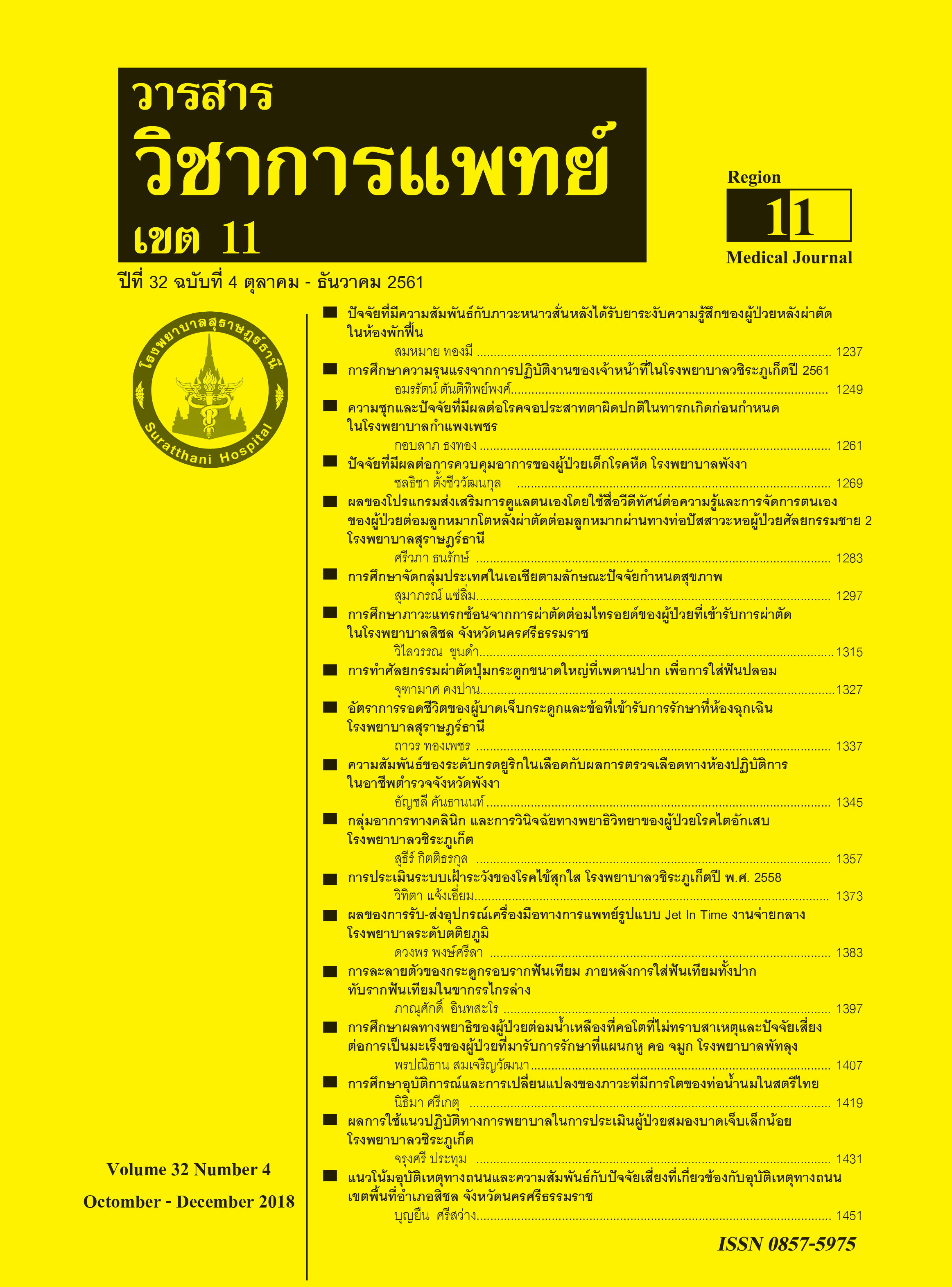ผลการใช้แนวปฏิบัติทางการพยาบาลในการประเมินผู้ป่วยสมองบาดเจ็บเล็กน้อย โรงพยาบาลวชิระภูเก็ต
คำสำคัญ:
สมองบาดเจ็บเล็กน้อย, แนวปฏิบัติทางการพยาบาล, การประเมินบทคัดย่อ
ผู้ป่วยสมองบาดเจ็บเล็กน้อยเป็นผู้ป่วยส่วนใหญ่ที่มารับบริการที่แผนกอุบัติเหตุฉุกเฉิน ซึ่งมักถูกจำหน่ายให้กลับบ้าน แม้ว่าเป็นการบาดเจ็บที่ไม่อันตราย แต่ผู้ป่วยอาจเกิดภาวะแทรกซ้อน เช่น เลือดออกในสมองตามมาได้ การประเมินอย่างละเอียดและครอบคลุมถึงภาวะเสี่ยงจะช่วยให้ผู้ป่วยมีความปลอดภัยมากขึ้น การศึกษาครั้งนี้มีวัตถุประสงค์เพื่อ ศึกษาผลการใช้แนวปฏิบัติทางการพยาบาลในการประเมินผู้ป่วยสมองบาดเจ็บเล็กน้อยที่แผนกอุบัติเหตุฉุกเฉิน และเปรียบเทียบอัตราการกลับมารักษาซ้ำภายใน 72 ชั่วโมงของผู้ป่วยสมองบาดเจ็บเล็กน้อยก่อนและหลังการใช้แนวปฏิบัติ โดยนำแนวทางเวชปฏิบัติกรณีสมองบาดเจ็บมาปรับใช้ในหน่วยงานด้วยกลยุทธ์ CLEVER model กับกลุ่มตัวอย่างสมองบาดเจ็บจากทุกสาเหตุ อายุ >15 ปี GCS > 13 และไม่ได้รับบาดเจ็บระบบอื่นร่วม
เก็บรวบรวมข้อมูลระหว่างเดือนมีนาคม-ตุลาคม พ.ศ. 2560 วิเคราะห์ข้อมูลทั่วไปด้วยสถิติบรรยาย และเปรียบเทียบอัตราการกลับมารักษาซ้ำด้วยสถิติ Chi square
ผลการศึกษาพบว่า กลุ่มควบคุม 157 ราย อายุเฉลี่ย 38.75 ปี (SD=19.05) กลุ่มทดลอง 167 ราย อายุเฉลี่ย 37.10 ปี (SD=18.26) กลุ่มทดลองได้รับการประเมินความเสี่ยงอย่างครอบคลุม และมีความเหมาะสมในการส่ง CT brain มากกว่ากลุ่มควบคุม แต่ไม่พบความแตกต่างทางสถิติ สำหรับการให้เอกสารการดูแลตัวเองที่บ้านและการให้ลงนามในประวัติการรักษา พบว่ากลุ่มทดลองสูงกว่ากลุ่มควบคุมอย่างมีนัยสำคัญทางสถิติ ( 2=11.928, P=.001;
2=68.34, P=.000 ตามลำดับ) และจำนวนผู้ป่วยที่กลับมารักษาซ้ำภายใน 72 ชั่วโมงหลังการจำหน่าย กลุ่มทดลองน้อยกว่ากลุ่มควบคุม แต่ไม่พบความแตกต่างอย่างมีนัยสำคัญทางสถิติ (
2=.021, p=.884)
สรุปผลการศึกษา การนำใช้แนวปฏิบัติทางการพยาบาลในการประเมินผู้ป่วยสมองบาดเจ็บเล็กน้อยด้วยกลยุทธ์ CLEVER model ทำให้พยาบาลมีการนำใช้แนวปฏิบัติมากขึ้น และผู้ป่วยได้รับการประเมินความเสี่ยงเพิ่มขึ้น
เอกสารอ้างอิง
and persistent symptoms. Brain injury; 2015;29(6):688-700. 2015;29(6):688-700.
ศูนย์ข้อมูลสุขภาพของกระทรวงสาธารณสุข (Health data center: HDC) [serial online] 2561.Available form: URL : https://hdc-service.moph.go.th/hdc/reports/page.
php?cat_id=491672679818600345dc1833920051b2
Holm L, David Cassidy J, Carroll L, Borg J. Summary of the WHO collaborating centre for neurotrauma task force on mild traumatic brain injury. J Rehabil
Med; 2005;37(3):137-41..
Teasdale G, Jennett B. Assessment of coma and impaired consciousness: a practical scale. The Lancet; 1974 ;304 (7872):81-4.
Tavender EJ, Bosch M, Gruen RL, Green SE, Knott J, Francis JJ, et al. Understanding practice: the factors that influence management of mild traumatic brain
injury in the emergency department a qualitative study using the Theoretical Domains Framework. Implement Sci;2014;9(1):8.
Selassie AW, Fakhry SM, Ford DW. Population-based study of the risk of in-hospital death a fter traumatic brain injury: the role of sepsis. J Trauma Acute Care Surg; 2011;71(5):1226-34.
Ponsford JL, Spitz G, McKenzie D. Using post-traumatic amnesia to predict outcome after traumatic brain injury. J Neurotraum; 2016;33(11):997-1004.
วิราวัณย์ พานทอง, โยทะกา ภคพงศ์. การพัฒนาแนวปฏิบัติทางการพยาบาลในการประเมินผู้ป่วยบาดเจ็บศีรษะเล็กน้อยในแผนกอุบัติเหตุฉุกเฉิน. วารสารวิทยาลัยพยาบาล พระปกเกล้า จันทบุรี; 2556; 24:44-56.
ยุวรรณา หวังกีรติกานต์, อัปสร สารสุวรรณ, เพ็ญฉาย เลิศศุภวงศ์. ประสิทธิผลของการพัฒนารูปแบบการดูแลผู้ป่วยบาดเจ็บที่ศีรษะรุนแรง. วารสารการแพทย์ โรงพยาบาลศรีสะเกษ
สุรินทร์ บุรีรัมย์; 2557; 29: 1-12.
สลิลดา มั่นคง, วิรดา อรรถเมธากุล. การพัฒนาแนวปฏิบัติทางคลินิกเพื่อป้องกันภาวะแทรกซ้อนของผู้ป่วยบาดเจ็บที่ศีรษะโรงพยาบาลราชบุรี. วารสารการพยาบาลและการศึกษา; 2557; 7: 62-70.
สวิง ปันจัยสีห์, นครชัย เผื่อนปฐม, และกุลพัฒน์วีรสาร. แนวทางเวชปฏิบัติกรณีสมองบาดเจ็บ (Clinical Practice Guidelines for Traumatic Brain Injury). พิมพ์ครั้งที่1. กรุงเทพมหานคร,
บริษัท ธนาเพรส จำกัด;2556.
Shatpattananunt B, Petpichetchian W, Kitrungrote L. Development of the change implementation strategies model regarding evidence-based chronic wound
pain management. Pac Rim Int J Nurs Res Thail; 2015 ;19(4):359-72.
Wong JJ, Côté P, Shearer HM, Carroll LJ, Yu H, Varatharajan S, et al. Clinical practice guidelines for the management of conditions related to traffic collisions:
a systematic review by the OPTIMa Collaboration. Disabil Rehabil; 2015;37 (6):471-89.
Bernard, R. Fundamentals of biostatistics (5th ed.). Duxbery: Thomson learning; 2000.p 384-385.
Fleiss, J. L., Levin, B., Paik, M. C. Statistical methods for rates and proportions (3rd ed.). John Wiley & Sons;2003. p76.
Ngamjarus C., Chongsuvivatwong V.n4Studies: Sample size and power calculations for android. The Royal Golden Jubilee Ph.D. Program - The Thailand Research Fund & Prince of Songkla University;2014
ศูนย์ข้อมูลอุบัติเหตุ Thai RSC ศูนย์ข้อมูล อุบัติเหตุ เพื่อเสริมสร้างวัฒนธรรม ความปลอดภัยทางถนน [serial online] 2017 [cited 2017 April 11] Available form: URL : http:// www.thairsc.com/th/BigAccDetail.aspx?qid=46748&l=th
ศิริกุล กุลเลียบ. การศึกษาข้อมูลการบาดเจ็บจากอุบัติเหตุรถจักรยานยนต์. ศูนย์วิชาการเพื่อความปลอดภัยทางถนน (ศวปถ.) /สำนักงานกองทุนการสร้างเสริมสุขภาพ ;2553.
Centers for Disease Control and Prevention. Heads up. Facts for physicians about mild traumatic brain injury (MTBI). Atlanta, GA: Centers for Disease Control and
Prevention; 2007. Available from: URL:http: // www.cdc.gov/ncipc/pub-res/tbi_toolkit/physicians/mtbi/ mtbi.pdf.
Carroll, L.J., Cassidy, J.D., Cancelliere, C.,Côté, P., Hincapié, C.A., Kristman, V.L.,et al. Systematic review of the prognosis after mild traumatic brain inj
ury in adults: cognitive, psychiatric, and mortality outcomes: results of the International Collaboration on Mild Traumatic Brain Injury Prognosis. Arch Phys Med Rehab; 2014; 95(3), pp.S152-S173.
Marshall S, Bayley M, McCullagh S, Velikonja D, Berrigan L. Clinical practice guidelines for mild traumatic brain injury and persistent symptoms. Can Fam Physician; 2012;58(3):257-67






